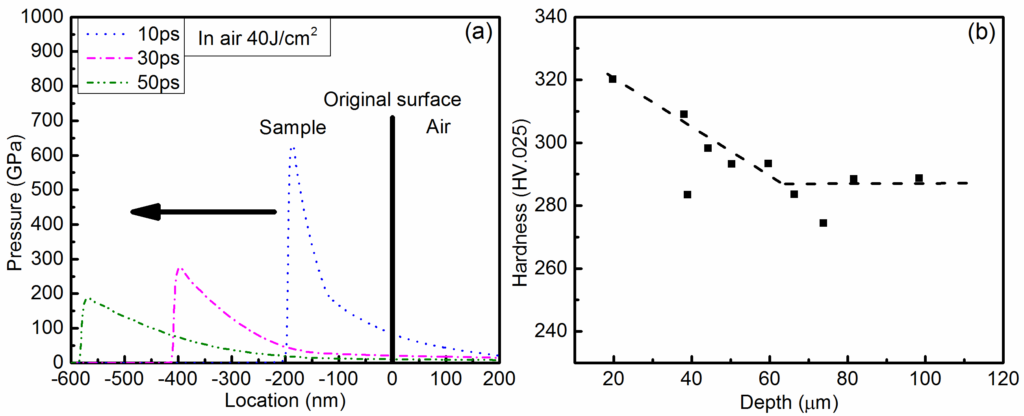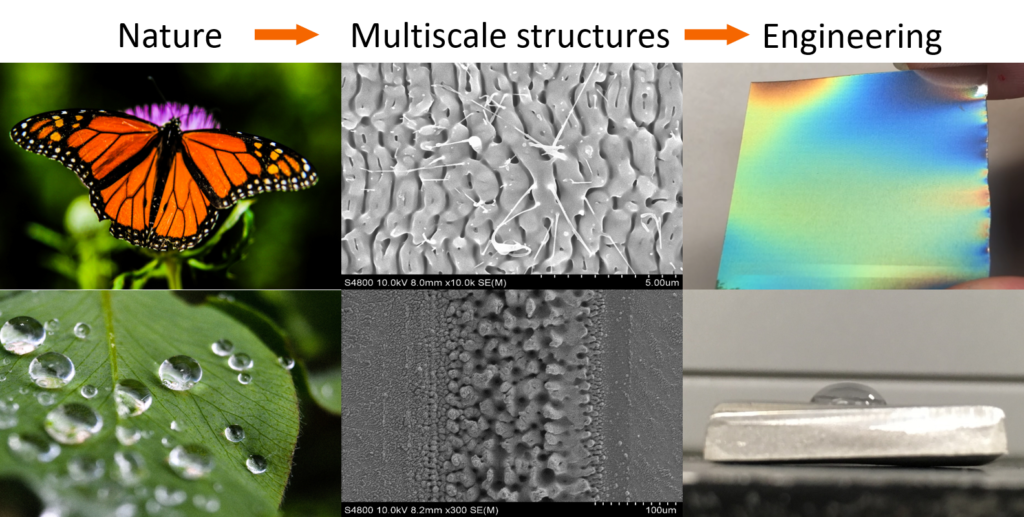Ultrafast laser shock peening
Laser induced, localized shock waves can generate compressive stresses in a metal’s surface that improve the hardness and fatigue of the part without altering its bulk material properties. The application of traditional nanosecond laser shock peening is limited by the requirement of protective coatings and confining medium, which add extra cost and setup complexity. This research will advance the understanding of the fundamental mechanisms of femtosecond laser shock peening process (fs-LSP), which has much higher energy density, to achieve the same result without the need for the protective coating and confinement layer. Through both experimental study and numerical modelling, we will investigate non-equilibrium electron dynamics and super-high strain-rate deformation mechanisms during fs-LSP and test its effects on microstructure, residual stress, surface hardness, and fatigue.

Sponsor: National Science Foundation
Ultrafast laser micromachining
High aspect ratio and high quality microchannels in transparent materials are critical in many important areas, such as micro-optics, microelectronics, micromechanics, and biomedicine. However, it is difficult to fabricate them using traditional machining techniques, due to the brittle nature and low thermal conductivity often found in transparent materials. Femtosecond pulsed lasers offer the potential to overcome these difficulties. This research thrust focuses on the fundamental study of ablation mechanisms of dielectrics by ultrafast lasers and material ejection dynamics to enable significant improvement in the quality and aspect ratio of microchannels produced by femtosecond pulsed lasers.

Sponsor: National Science Foundation
Multi-scale surface structuring
There are numerous biological systems with fascinating functionalities enabled by multiscale surface structures, such as self-cleaning lotus leaves, anti-fogging mosquitoes compound eyes, highly adhesive feet of geckos, colorful peacock feathers and butterfly wings, etc. Inspired by nature, ultrafast laser surface structuring is a promising technique to create multifunctional surfaces on different engineering materials with great throughput. This project will study the fundamental mechanisms of structure formation by ultrafast lasers and the establish the process-structure-property relationship.

Dissimilar materials joining
To improve the fuel economy while retaining or further improving the structural integrity, the automobile industry is vigorously shifting towards substituting conventional heavy materials like cast iron with a mix of different new age materials which are not only much lighter but also offer superior strength-to-weight ratio. However, the utilization of such materials is currently limited in the industry due to the difficulties of joining different materials. Dissimilar material joining is of critical importance in aiding the manufacturers realize the crucial objective of a safer and more fuel-efficient vehicle. This project aims to study a novel friction-based dissimilar material joining technique: friction element welding (FEW), which join a variety of materials with high throughput, high joint strength, and low input energy. The fundamental joining mechanisms and the process-structure-property relationship will be unveiled by experimental studies, numerical modelling, and high resolution in-situ monitoring by micro-sensors.

Collaborators: Dr. Laine Mears and Dr. Hongseok Choi
Sponsor: Honda R&D Americas
